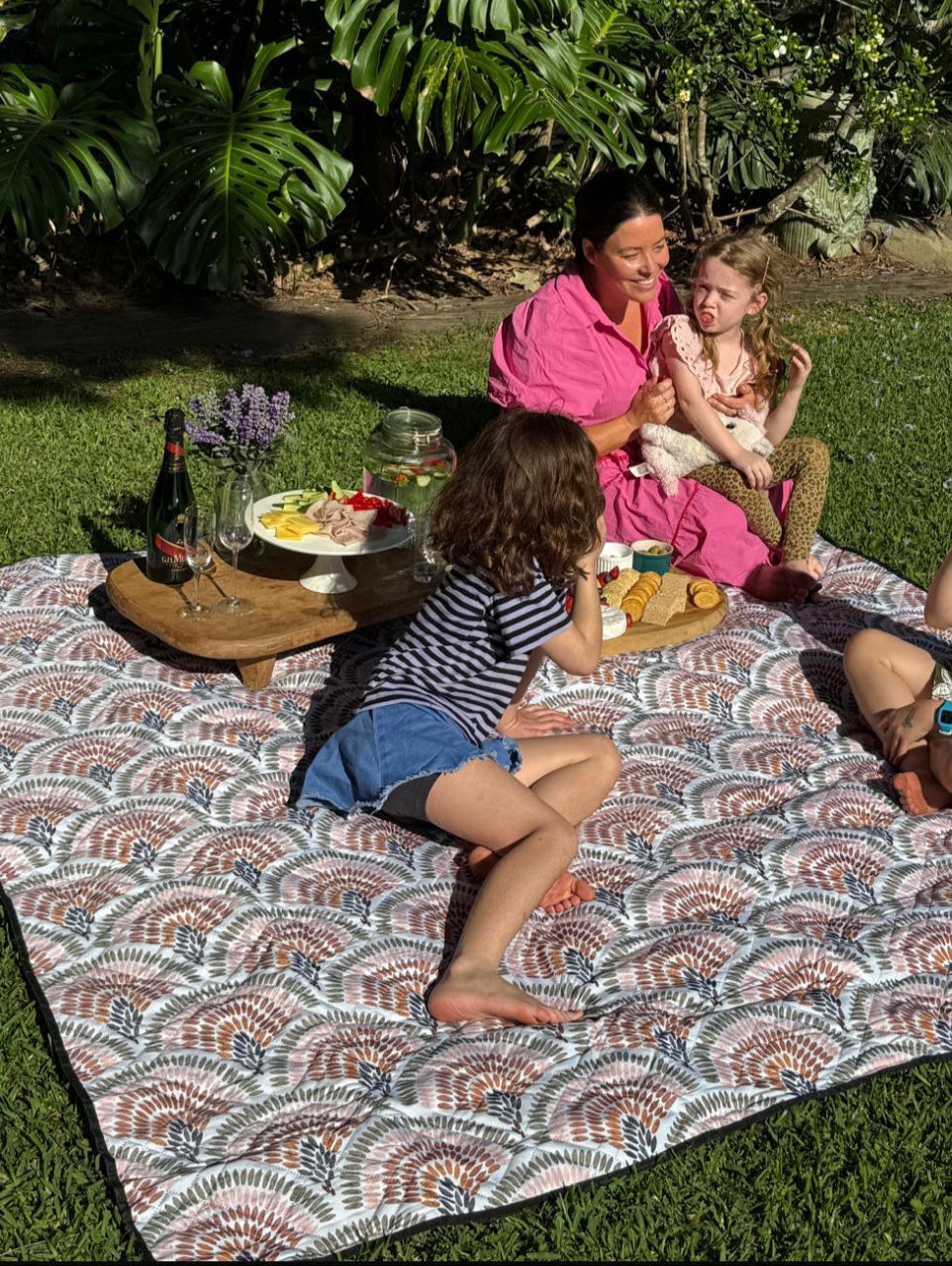If you’re confused about the difference between water resistant and waterproof, don’t worry, you’re in very good company. The debate around what makes a product water-resistant versus waterproof is one for the ages.
The reality is, most people don’t truly understand the difference between waterproof and water resistant. The marketing agency we used when we launched Saltwater Picnic Co. were definitely like “most people". I almost died when one of our ads landed in my feed spruiking a waterproof picnic blanket.

A lot of picnic rug companies say their rugs are waterproof when they are most definitely not, with the high volume of searches made on Google for terms like Waterproof Picnic Rugs, Waterproof Picnic Blankets and Waterproof Picnic Mats it's probably one of those, better to ask for forgiveness versus permission type scenarios.
Given the popularity of people seemingly wanting waterproof versus water resistant picnic rugs, I bet you are wondering why we chose to make Saltwater Picnic Co. rugs water resistant and water repellent, versus waterproof?
It’s a very valid question, and the reason why I wanted to write this article, as like the majority of Google searches, both myself and my wife Emma thought that waterproof was a must have in a rug, so much so it was #2 on Emma's list that she gave me when we set out to find someone to make us the perfect picnic rug.
It wasn’t until I spoke with almost every fabric expert on the planet that I finally understood the difference between waterproof and water resistant and also worked out that water resistant and water repellent picnic rug will run rings around a waterproof one, as waterproof materials have a lot of shortcomings when you think of the functionality a picnic rug needs.
Before we go any further, let’s check out the Oxford English Dictionary definitions of waterproof, water-resistant, and one that is rarely mentioned but equally important … water-repellent.

Water-resistant - Able to resist the penetration of water to some degree but not entirely.
Water-repellent - Not easily penetrated by water, especially as a result of being treated for such a purpose with a surface coating
Waterproof - Impervious to water
So waterproof means that the materials used in a product are impervious to all water penetration while it remains totally sealed. When it comes to waterproof picnic mats, the backing is usually made from a PVC style material, which will make the picnic blanket waterproof, but as I found through my tests of many rugs, it won’t make them very functional.
The first issue I experienced with my testing was trying to use the rugs without damaging the PVC. Picnicking is an outdoor activity which is rarely on pristine manicured lawns, so things like sticks and rocks are prevalent in most places you will want to set up.
The problem with sharp items and PVC material is that once any weight is applied (like a person sitting on a rug) the sharp object easily penetrates the PVC and the rug is not only damaged, but it is also not waterproof anymore.

The second red flag raised with the waterproof rugs was their inability to breathe, which for me made them feel hot to sit on after a while, and they would sweat profusely when in a bag in the boot of a car. One example was so bad that it had formed mould on it only after a couple weeks stored away.
Waterproof rugs are in general heavier too, so not as easy to carry as their non waterproof counterparts. They also are less flexible, which made them never sit perfectly on the ground which would make them feel a little weird to sit on, and it made more noise when you shifted your position than other rugs I tested.
I also tested some canvas picnic blankets that were treated with a waterproof coating, but again they were heavy, hot and didn’t breathe well. The other issue we would face if we stuck with the waterproof route, was that it eliminated the chance of Emma getting the number one thing on her list, which was a machine washable picnic rug and there was no chance to use recycled materials, Emma's #3 item on the list.
As you might have figured, at the end of testing the waterproof side of picnic rugs we knew it wasn’t for us, for all of the reasons I mentioned, but also when you really dig down to what you need from a picnic mat. No one is going to see a body of water and think, that's where I want to set up a picnic, so being fully waterproof is kind of pointless when you look at it.
When I circled back to Emma around her #2 list item, she clarified that it needed to be able to be set up on wet dewy grass without the wet soaking through. So my search moved from waterproof to something water resistant enough to tick the dewy grass box.
Water-resistant, means that a material repels the effects of water to a point, but after a period of exposure, or amount of pressure, water will either soak or seep through the item. Water resistant fabrics are entirely different from waterproof fabrics, they will shed water and dry quickly, they are normally lighter and they breathe better because air can pass through the weaves in its fabric.
The samples we tested from multiple manufacturers were all passing the wet test, but where we saw the best results overall, was when a water resistant fabric was treated with a water repealing nanotechnology that made water bead on the fabric. Making it in a sense Hydrophobic and preventing the fabric from saturating and providing another awesome benefit in making the material stain proof and sand proof, which wasn’t on Emma’s list but was a welcomed additional benefit.

The only challenge left was to find a recycled fabric that we could get woven tight enough for water to struggle to get through. After numerous attempts we found a manufacturer that could do it, turning no less than 96 plastic water bottles into enough fabric to make the rug 100% with recycled fabrics.
So we started off wanting to produce a waterproof picnic rug but ended with something so much better and more practical for what you need a picnic blanket to be. The fact that we have a stain and sand proof, water resistant, machine washable picnic mat made from recycled fabrics still blows me away today, and I wouldn’t change a thing.




